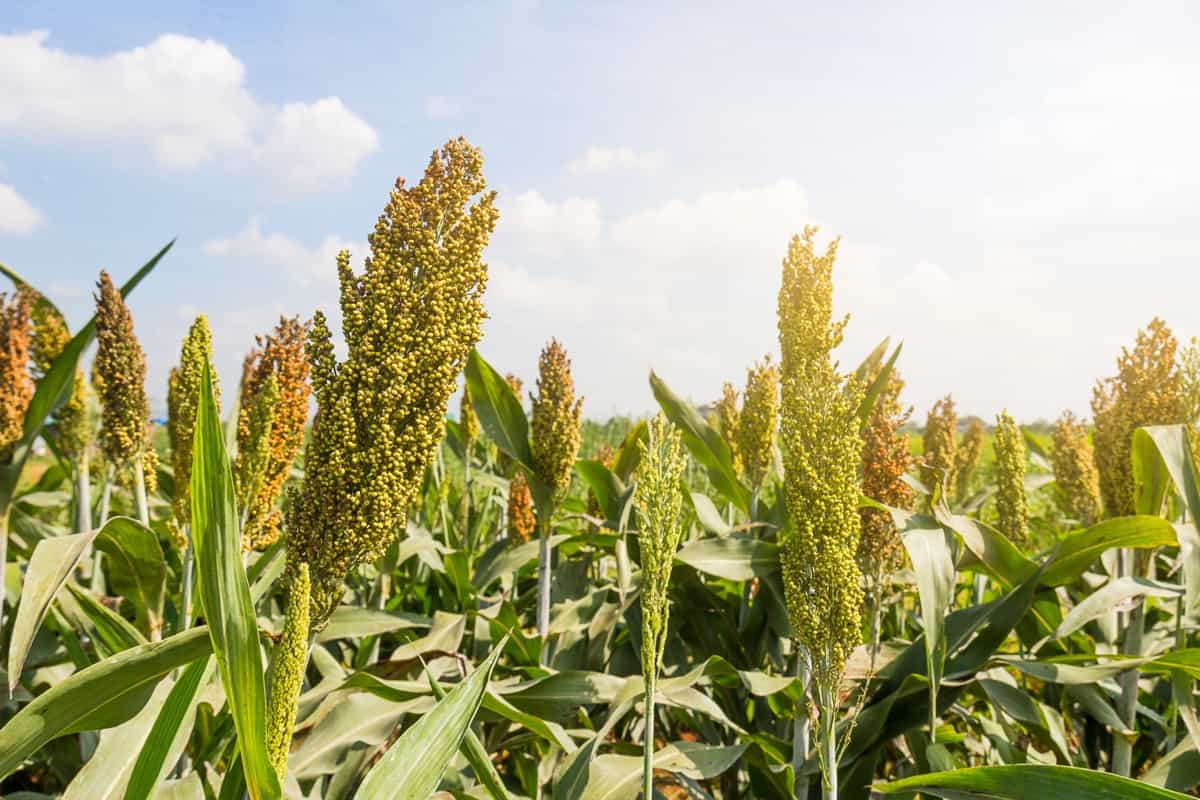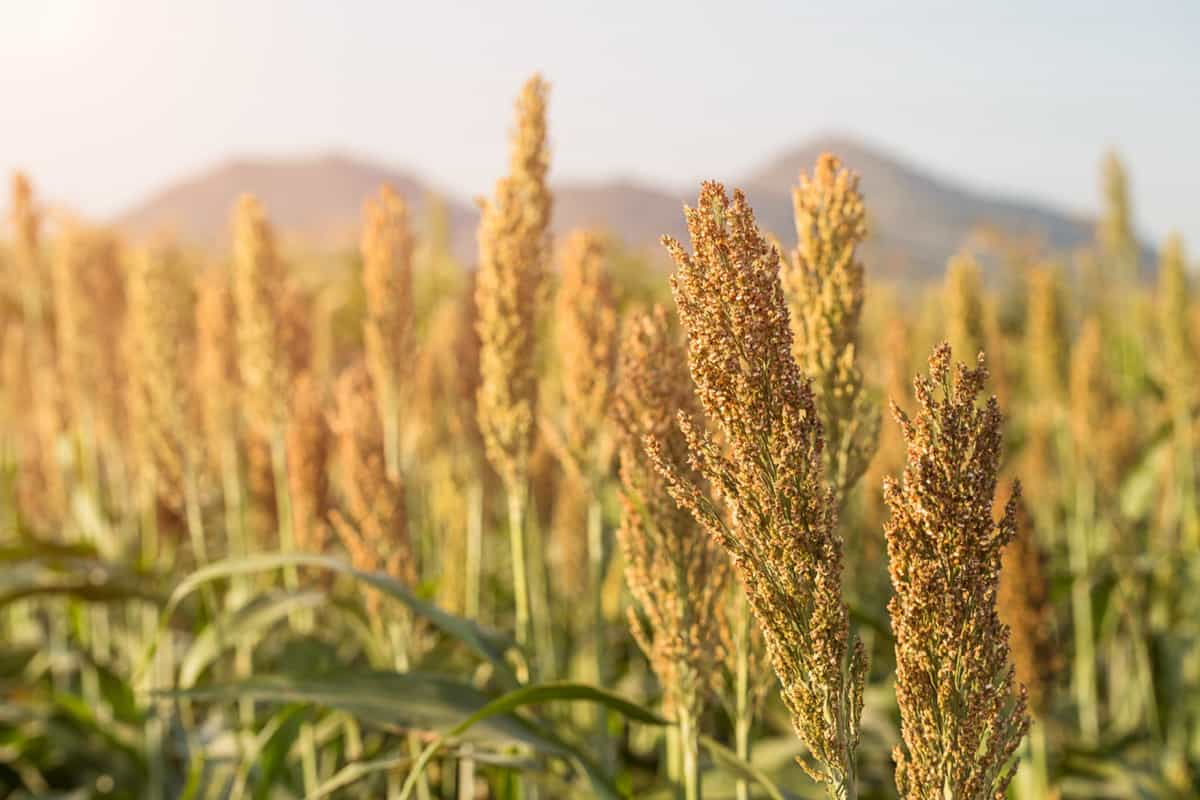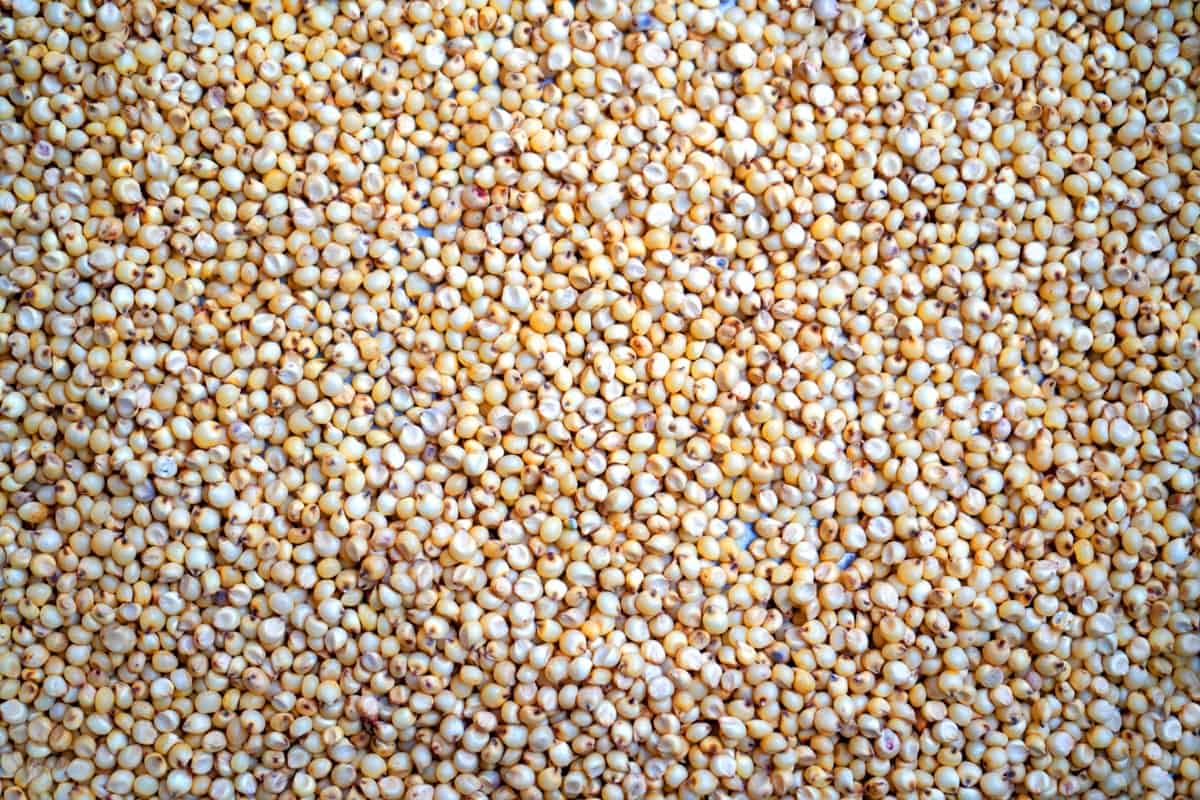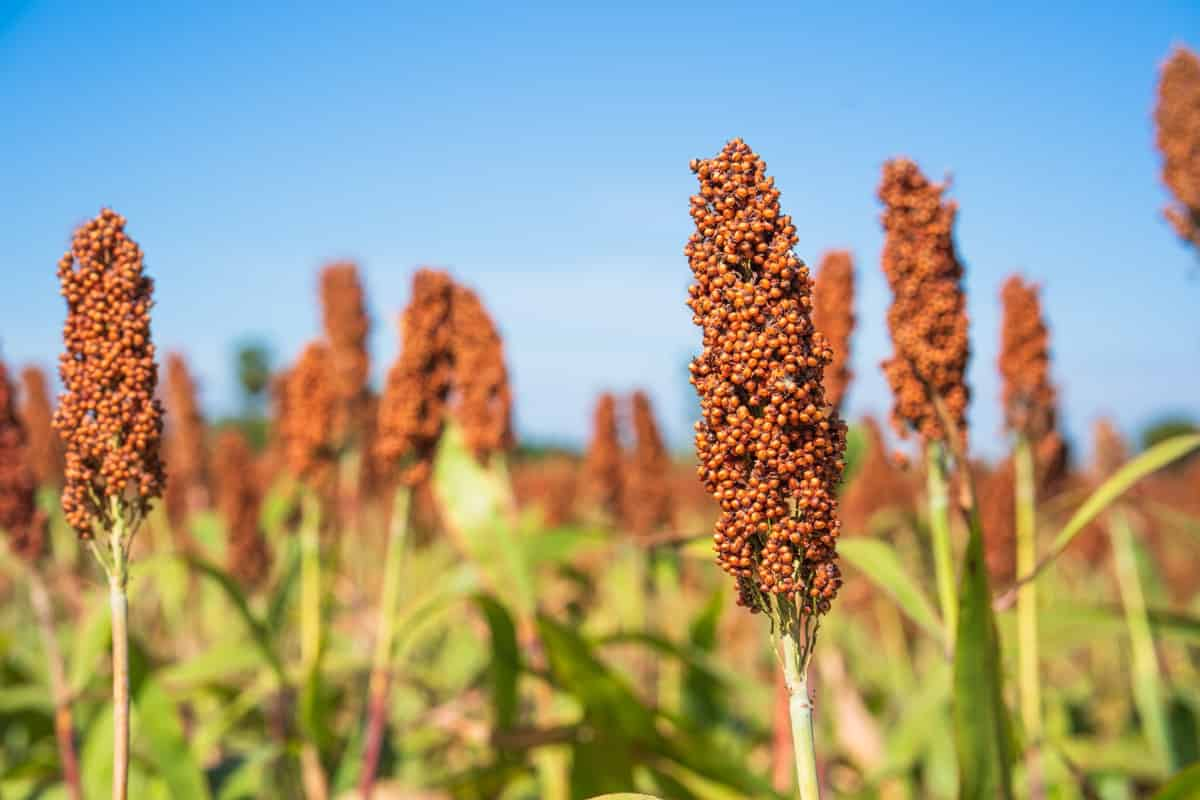Welcome to our comprehensive guide on weed management in sorghum farming! As any farmer knows, weeds can quickly overrun a sorghum field, jeopardizing its health and yield. But fear not. We’ve covered you with simple and effective strategies to tackle these pesky intruders. Through accurate data and expert advice, we’ll walk you through essential techniques, from pre-planting preparations to post-emergence weed control. Get ready to boost your sorghum crop’s potential and minimize weed interference.

What is Weed Management in Sorghum Farming?
Weed management in sorghum refers to the systematic approach of controlling and preventing the growth of unwanted plants (weeds) within sorghum fields. Weeds compete with sorghum crops for essential resources like water, nutrients, and sunlight, hindering their growth and reducing yields.
Effective weed management techniques include both chemical and non-chemical methods. Pre-planting practices, such as proper land preparation and weed seed bank reduction, are essential to curb weed growth. Post-emergence herbicides and mechanical weed control can be employed during the growing season, like hoeing or hand-weeding.
Integrated Weed Management in Sorghum
Weed competition is a significant stress factor in sorghum fields, and neglecting weed management can severely impact productivity. Weeds, taking advantage of wider row spacing and slow initial growth in sorghum, can reduce yields by 15% to 97%, depending on the severity of infestation. Early competition, particularly from grassy weeds, is crucial for effective weed management.
Hand weeding and mechanical cultivation between rows have been the conventional approaches. Still, studies reveal that narrowing crop rows, increasing plant densities, and choosing competitive cultivars can effectively suppress weed growth through crop competition. Herbicides are not commonly used, but pre-emergence herbicides provide early control during rainy seasons when timely hand weeding or mechanical cultivation may be uncertain.
Integrated weed management combines agronomic practices, judicious herbicide use, and minimal hand weeding to control weeds. Like short-duration legumes, smother crops can be intercropped to replace pre-emergence herbicides or one-hand weeding. In arid conditions, herbicide-tolerant sorghum cultivars allow weed control with non-selective herbicides.
Chemical Weed Control in Sorghum
Chemical weed control in sorghum involves using various herbicides with different action sites, timings, and possibly tillage practices. Atrazine is a fundamental component of most sorghum herbicide programs, offering broad-spectrum control of broadleaf and grassy weeds. When combined with acetamide herbicides, Atrazine becomes even more effective against a wider range of weeds.
To enhance control of pigweeds, kochia, velvetleaf, and common cocklebur, mesotrione or saflufenacil can be added to the herbicide mix. In recent years, herbicide-tolerant sorghum has emerged through conventional breeding, enabling nicosulfuron for post-emergence control of annual grasses. For comprehensive weed management, a combination of pre-emergence and post-emergence herbicides is necessary.
In case you missed it: Sorghum Farming in the Philippines: A Step-by-Step Production Guide

More reliance on postemergence-only herbicide programs could succeed, especially when facing problem-resistant weeds. By incorporating a well-designed chemical weed control strategy, sorghum growers can effectively combat weed competition and enhance their crop’s productivity.
Sorghum Crop Mechanical Weed Control
Mechanical weed control in sorghum crops involves physical methods to manage weeds without herbicides. Various techniques are employed, such as hand-weeding, hoeing, and mechanical cultivation. Hand-weeding targets specific weeds, but it can be labor-intensive and time-consuming. Hoeing effectively removes weeds between rows, while mechanical cultivation uses specialized equipment to uproot weeds mechanically.
Mechanical weed control can particularly benefit sorghum fields with heavy weed infestations. The timing of mechanical operations is critical, and early intervention is vital to prevent weed competition during the critical growth stages of crop cycle. Such as soil disturbance can lead to soil erosion and damage to the crop’s root system. A combination of mechanical weed control and other integrated management practices can be the key to successful weed management in sorghum.
Pre-emergence Sorghum Weed Control Herbicides
Pre-emergence herbicides are weed control chemicals applied to the soil before weed seeds germinate and emerge from the ground. These herbicides are specifically designed to target weed seeds or young weed seedlings, preventing them from developing and competing with crops for essential resources like water, nutrients, and sunlight.
- Atrazine: Atrazine is a widely-used pre-emergence herbicide with broad-spectrum activity against grassy and broadleaf weeds. It inhibits photosynthesis in plants, leading to weed control.
- S-metolachlor: S-metolachlor is a selective herbicide targeting grasses and broadleaf weeds. It disrupts protein synthesis in susceptible weeds, preventing their growth.
- Metolachlor: Similar to S-metolachlor, metolachlor is also a selective herbicide that provides pre-emergence control of grasses and certain broadleaf weeds.
- Dimethenamid-P: Dimethenamid-P targets early-emerging grass and broadleaf weeds. It inhibits cell division in susceptible weeds, hindering their growth.
- Isoxaflutole: Isoxaflutole is a pre-emergence herbicide effective against broadleaf weeds. It interferes with carotenoid biosynthesis in weeds, ultimately leading to their demise.
Effective Sorghum Weed Control: Post-emergence Herbicides
Post-emergence herbicides are weed-killing substances applied to sorghum plants after they have sprouted. These herbicides are designed to target and eliminate weeds that have already emerged, providing targeted and efficient weed control.
- Nicosulfuron: A potent herbicide that targets grassy weeds, nicosulfuron disrupts weed growth by inhibiting enzyme activity crucial for plant development. It’s particularly effective against annual grasses in sorghum fields.
- Mesotrione: This herbicide provides broad-spectrum control against broadleaf and grassy weeds by hindering photosynthesis. It’s valuable for managing various weed species, including pigweeds and foxtails.
- Halosulfuron-methyl: Known for its extended residual activity, this herbicide is highly effective against broadleaf and sedge weeds. It interferes with weed growth by disrupting amino acid synthesis.
- Clethodim: Targeting grassy weeds, clethodim inhibits lipid synthesis, causing cell membranes to break down. It’s especially useful for controlling grassy weeds that can outcompete sorghum crops.
- Dicamba: While it should be used cautiously due to its potential to affect neighboring plants, dicamba is effective against broadleaf weeds by disturbing their growth regulation.
In case you missed it: Sorghum Farming in Kenya: A Step-by-Step Production Guide

Sorghum Field Selective Herbicides for Specific Weeds
Selective herbicides manage specific weeds in sorghum fields while preserving the sorghum crop. These herbicides target certain weed species without harming the sorghum plants, offering an efficient and environmentally friendly weed control solution. One example of a selective herbicide used in sorghum farming is Atrazine.
Atrazine targets a wide range of broadleaf and grassy weeds, making it effective against several problematic species such as pigweeds (Amaranthus sp.), kochia, velvetleaf, and common cocklebur (Xanthium strumarium L.). Another effective selective herbicide is nicosulfuron, which is particularly useful for controlling annual grasses in sorghum fields.
Selective herbicides are formulated to act on specific biochemical processes within the target weeds, leaving the sorghum plants unaffected. This targeted approach minimizes crop damage while ensuring successful weed control, contributing to higher sorghum yields and farm productivity.
Broad-spectrum Sorghum Weed Control using Non-selective Herbicides
Broad-spectrum sorghum weed control can be achieved using non-selective herbicides that target a wide range of weed species. Non-selective herbicides, like glyphosate, are designed to kill all types of plants they come into contact with. When using glyphosate for weed control in sorghum fields, it’s important to apply it carefully to avoid damaging the sorghum crop itself.
One effective approach is using glyphosate in a pre-plant burndown application before planting sorghum. This helps eliminate existing weeds and creates a clean seedbed for sorghum establishment. Additionally, non-selective herbicides can be utilized in spot treatments or non-crop areas to control persistent weeds that may resist other herbicides.
Sorghum Farming Cultures to Reduce Weed Competition
Sorghum farming cultures aim to reduce weed competition and optimize crop productivity. Research shows that implementing certain cultural practices can effectively suppress weed growth, minimizing the negative impact on sorghum crops. One effective approach is adjusting planting dates to avoid synchronizing with the dominant weed species’ germination period. This way, sorghum plants get a head start and outcompete the weeds.
Additionally, selecting sorghum varieties with vigorous early growth can provide a competitive advantage over weeds. Narrowing row spacing also reduces inter-row weed growth, benefiting crop development. Intercropping sorghum with leguminous smother crops is another valuable strategy, as they prevent weed establishment and competition. Moreover, integrating cover crops into the farming system can create a living mulch that suppresses weeds and enhances soil health.
Sorghum Weed Control with Mulching
Sorghum weed control with mulching cover is an effective and sustainable approach to suppress weed growth and enhance crop productivity. Mulching involves covering the soil around sorghum plants with organic materials like straw, leaves, or plastic films. Scientific research confirms that mulching reduces weed emergence, competition, and seed germination, yielding higher sorghum.
In case you missed it: Best Fertilizer for Sorghum/Jowar: Organic, NPK, Bio-fertilizers, Requirements, When and How to Apply

The mulch is a physical barrier, limiting sunlight access to weed seeds and seedlings and hindering their growth. Additionally, it conserves soil moisture, reducing the stress on sorghum plants and promoting healthy growth. Studies indicate that mulching improves soil structure, nutrient retention, and microbial activity, further benefiting sorghum production. Moreover, mulching reduces the need for chemical herbicides, making it an environmentally friendly weed management practice.
Sorghum Field Crop Rotation for Weed Management
Crop rotation is a proven weed management strategy for sorghum fields, supported by research. By alternating sorghum with different crops, weed populations can be effectively reduced, minimizing the need for chemical intervention. Studies have shown that rotating sorghum with non-host crops disrupts weed life cycles, decreasing weed infestation in subsequent sorghum crops.
For example, planting legumes like soybeans or cowpeas in the rotation cycle can suppress certain weed species through allelopathic effects and nitrogen fixation. Additionally, growing cover crops during fallow periods can prevent weeds from establishing and competing with sorghum plants. A diverse crop rotation plan helps control weeds and improves soil health and fertility, leading to better crop performance.
Sorghum Weed Control Through Biological Methods
Sorghum weed control through biological methods offers sustainable and eco-friendly alternatives to chemical interventions. One effective approach involves utilizing allelopathic plants, such as sunflower, which release natural chemicals inhibiting weed growth. Another method is using cover crops like cowpea or soybean, which create a dense canopy and smother weeds, reducing their competitiveness. Additionally, intercropping sorghum with legumes, such as pigeon peas, can help suppress weeds through competition for resources.
In case you missed it: Organic Proso Millet Farming: Cultivation Practices and Production Management

Employing beneficial insects, like ladybugs and lacewings, can also curb weed populations. Utilizing bioherbicides derived from fungi or bacteria has shown promising results in weed management. For example, products containing mycoherbicides effectively target specific weed species while minimizing harm to sorghum. Integrating these biological methods into sorghum farming practices can control weeds and enhance soil health and biodiversity.
Management of Herbicide-resistant Weeds in Sorghum Crops
Herbicide-resistant weeds in sorghum crops have developed the ability to survive and reproduce even when exposed to herbicides that were previously effective in controlling them. This resistance results from genetic mutations in the weed population, allowing certain individuals to withstand the herbicide’s mode of action. The management of herbicide-resistant weeds in sorghum requires a strategic approach.
Crop rotation and diversified weed management practices can help reduce selection pressure on resistant weeds. Implementing integrated weed management, including using multiple herbicide modes of action, cultural practices, and mechanical control, can improve weed control efficacy and reduce the likelihood of further resistance development. Monitoring fields for early detection of resistant weeds is crucial to take prompt action.
Sorghum Weed Scouting and Monitoring for Early Detection
Early detection allows farmers to intervene promptly and prevent weed competition from harming sorghum yields. To carry out effective scouting, experts recommend regular field walks, particularly during the critical stages of crop growth. Farmers should carefully observe the sorghum field during these walks, paying attention to any signs of weed infestation.
Timely detection of weeds, such as grassy and broadleaf weeds, enables farmers to select the most appropriate control measures. Integrating digital tools and smartphone apps can enhance the efficiency of weed scouting, simplifying data collection and analysis. Experts advise that scouting should not be a one-time activity but a continuous process throughout the growing season.
Sustainable Weed Management for Long-Term Sorghum Production
Integrated weed management practices combine strategies to minimize weed interference while promoting environmental and economic sustainability. One key approach involves cultural practices, such as crop rotation, intercropping, and cover cropping, which disrupt weed growth cycles and enhance soil health.
In case you missed it: Organic Little Millet Farming: Cultivation Practices and Production Management

Additionally, adopting conservation tillage methods reduces soil disturbance and helps retain soil moisture, thus discouraging weed growth. Implementing targeted and timely herbicide applications using appropriate herbicide-resistant sorghum cultivars can further enhance weed control. By using beneficial insects or microorganisms, biological control methods can complement chemical and mechanical weed control approaches.
Conclusion
Effective weed management is crucial for successful sorghum farming, ensuring higher yields and sustainable production. Integrating cultural, chemical, and biological methods will lead to a weed-free and thriving sorghum crop.
- Types of Pesticides Used in Agriculture: A Beginner’s Guide
- Economical Aquaculture: A Guide to Low-Budget Fish Farming
- 15 Common Planting Errors That Can Doom Your Fruit Trees
- How to Make Houseplants Bushy: Effective Tips and Ideas
- Innovative Strategies for Boosting Coconut Pollination and Yield
- Pollination Strategies for Maximum Pumpkin Yield
- The Complete Guide to Chicken Fattening: Strategies for Maximum Growth
- Natural Solutions for Tulip Problems: 100% Effective Remedies for Leaf and Bulb-Related Issues
- Revolutionizing Citrus Preservation: Towards a Healthier, Greener Future
- Natural Solutions for Peony Leaf and Flower Problems: 100% Effective Remedies
- Maximizing Profits with Avocado Contract Farming in India: A Comprehensive Guide
- Natural Solutions for Hydrangea Problems: 100% Effective Remedies for Leaf and Flowers
- The Ultimate Guide to Choosing the Perfect Foliage Friend: Bringing Life Indoors
- From Sunlight to Sustainability: 15 Ways to Use Solar Technology in Agriculture
- The Ultimate Guide to Dong Tao Chicken: Exploring from History to Raising
- The Eco-Friendly Makeover: How to Convert Your Unused Swimming Pool into a Fish Pond
- Mastering the Art of Delaware Chicken Farming: Essentials for Healthy Backyard Flocks
- 20 Best Homemade Fertilizers for Money Plant: DIY Recipes and Application Methods
- How to Craft a Comprehensive Free-Range Chicken Farming Business Plan
- Brighten Your Flock: Raising Easter Egger Chickens for Beauty and Bounty
- How to Optimize Your Poultry Egg Farm Business Plan with These Strategies
- Subsidy for Spirulina Cultivation: How Indian Government Schemes Encouraging Spirulina Farmers
- Ultimate Guide to Raising Dominique Chickens: Breeding, Feeding, Egg-Production, and Care
- Mastering the Art of Raising Jersey Giant Chickens: Care, Feeding, and More
- Ultimate Guide to Raising Legbar Chickens: Breeding, Farming Practices, Diet, Egg-Production
- How to Raise Welsummer Chickens: A Comprehensive Guide for Beginners
- How to Protect Indoor Plants in Winter: A Comprehensive Guide
- Ultimate Guide to Grow Bag Gardening: Tips, Tricks, and Planting Ideas for Urban Gardeners
- Guide to Lotus Cultivation: How to Propagate, Plant, Grow, Care, Cost, and Profit
- Agriculture Drone Subsidy Scheme: Government Kisan Subsidy, License, and How to Apply Online
- Ultimate Guide to Raising Araucana Chickens: Breed Profile, Farming Economics, Diet, and Care
- Bringing Hydroponics to Classroom: Importance, Benefits of Learning for School Students
- Ultimate Guide to Raising Polish Chickens: Breed Profile, Farming Economics, Diet, and Care
- Ultimate Guide to Raising Australorp Chickens: Profile, Farming Economics, Egg Production, Diet, and Care
- Silkie Chicken Farming: Raising Practices, Varieties, Egg Production, Diet, and Care
- Sussex Chicken Farming: Raising Practices, Varieties, Egg Production, Diet and Care